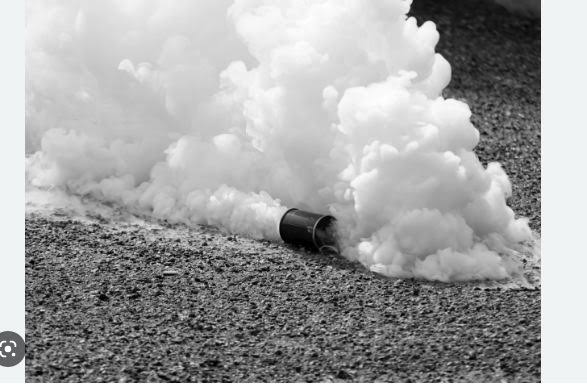News
Hunger protest: ophthalmologists caution against prolonged exposure to tear gas

Hunger protest: ophthalmologists caution against prolonged exposure to tear gas
*Says, it may cause blindness
By Francesca Hangeior
Leading eye specialists have cautioned that prolonged exposure to tear gas could cause temporary blindness and other eye complications, which if left untreated could lead to permanent blindness.
They also noted that people without protective clothes and devices were at risk of cornea injuries and conjunctivitis when exposed to tear gas.
The ophthalmologists advised those exposed to tear gas to quickly rinse their eyes and affected body parts with water.
The experts’ warning and advice comes on the heels of the 10-day protest that began on August 1st and had been marred with security agents firing tear gas to disperse protesters.
Under the #Endbadgovernance and #Hungerprotests, several Nigerians in several states of the federation, have through placards and chants demonstrated their displeasure with the current economic hardship.
But the President, Bola Tinubu, in an address to the nation on Sunday, told protesters and the organisers to suspend any further protest and create room for dialogue.
Tear gas is a riot control agent mostly used by law enforcement agents that temporarily constrain people by irritating the eyes, mouth, throat, lungs, and skin.
According to the Centre for Disease Control and Prevention, long-lasting exposure or exposure to a large dose of tear gas may cause blindness, glaucoma and respiratory failure possibly resulting in death.
However, a professor of Ophthalmology at the University of Benin, Edo State, Afekhide Omoti, stated that prolonged exposure to tear gas in an enclosed environment could cause blindness.
He, however, noted that the risk of blindness was reduced if the tear gas was used in an open environment.
The Chairman of the National Eye Health Committee said, “In the normal circumstances where tear gas is used in an open environment, it will not cause blindness.
“However, if there is prolonged exposure in a closed environment, it is possible that tear gas can cause blindness,” he said.
The researcher on Glaucoma and Anterior Segment Disorders further noted that physical exertion, such as running after contact with tear gas, makes the affected persons more susceptible to severe symptoms.
Omoti said, “As far as blindness is concerned, large doses may cause temporary blindness.
However, in very unusual circumstances, and depending on the delivery system, more prolonged damage can occur.
Explosive systems, particularly those used in the military, may cause thermal, chemical, and physical damage due to the blast. If left untreated, it can cause permanent blindness. But this is not the usual type used by the anti-riot police.”
The researcher on Glaucoma and Anterior Segment Disorders further noted that tear gas might worsen the conditions of persons with corneal problems but had no effect on those with cataracts and glaucoma.
He added, “Depending on the specific chemical agent used in the tear gas and the mode of delivery, tear gas can cause a variety of eye defects which include mild features such as blepharospasm, conjunctivitis and superficial keratitis.
“More severe complications which are very unlikely include corneal stromal opacities, corneal neovascularisation, neurotrophic keratopathy, conjunctival necrosis, and pseudopterygium. These are all problems with the cornea and conjunctiva, the surface structures of the eye.
“Ordinarily, those with glaucoma should not be at higher risk of blindness from tear gas use. However, if the explosive variety is used, and as I said earlier, this is not the usual type used in our civilian crowd control, then the physical effects may increase the intraocular pressure and worsen the glaucoma or even theoretically cause blindness in terminal stages. But I must again reiterate that this is not likely.”
The ophthalmologist asserted that if these eye defects were untreated, it could cause possible complications, which could lead to blindness.
“Untreated, possible complications which will cause blindness, especially in explosive cases include corneal neovascularisation, stromal thinning, ulceration, infection and perforation. Others include secondary glaucoma, cataract formation, vitreous haemorrhage and traumatic optic neuropathy which are physical complications of the explosive which are not normally used in civilian crowd control,” Omoti said.
Also, the President of the Ophthalmological Society of Nigeria, Dr Abiola Oyeleye, stated that tear gas affects the eyes and skin of those it comes in contact with, noting that when inhaled, it affects the lining of the mouth, nose, chest, lungs and the respiratory system.
The ophthalmologist emphasised that direct exposure of tear gas to the eyes could damage the eye structures and lead to blindness.
The Medical Director of the Eye Doctors Group of Clinics, said, “So if we are specific now about the eyes, what it does, it irritates the eye, and anything that irritates the eye causes tears, and that’s where the name tear gas is from. So the eye sends a message to the brain that something is irritating me and the brain now sends a message to the tear glands saying something is irritating the eye, send tears to the eye, the tear glands now function and send tears to the eye, so it’s a response to whatever agent has caused it, that’s where the name tear gas comes from. Pp
News
TETFUND threatens to cut financial support to non-performing institutions

The Tertiary Education Trust Fund (TETFUND) has threatened to cut financial support to beneficiary tertiary institutions that fail to meet performance benchmarks or mismanage allocated funds.
The agency said it would de-list such tertiary institutions from its support programmes.
Executive Secretary of TETFUND, Sonny Echono gave the warning at a one-day strategic engagement with heads of institutions, bursars, and heads of procurement of the agency’s beneficiary institutions in Abuja on Monday.
Echono said the policy was not meant to punish, but rather safeguard the credibility and impact of TETFUND interventions.
He said: “Let me be clear, institutions that consistently fail to access, utilise or retire funds appropriately, or that fall short of enrollment and academic performance thresholds, risk being delisted as TETFUND beneficiary institutions.”
He also disclosed the intention of TETFUND to ensure that its resources were directed towards institutions that were committed to high standards of governance, transparency, and accountability.
Echono said the strategic engagement was targeted at addressing recurring challenges in Nigeria’s tertiary education sector, improving project execution, and enhancing the quality of education.
A key focus, he said, was the Academic Staff Training and Development (AST&D) intervention.
He said due to rising costs and incidents of scholars absconding, the foreign component of the TETFUND Scholarship for Academic Staff (TSAS) was suspended as of January 1, 2025 with emphasis now shifted to cost-effective, locally driven training.
Echono said this year’s intervention budget prioritises consolidation, sustainability, and the completion of abandoned projects.
He added: “This engagement is not merely a meeting but a strategic convergence. It is designed to address recurring issues of concern, streamline project implementation, and enhance the overall quality of tertiary education delivery in our nation.
“As we move forward, let us approach today’s discussions with openness, collaboration, and a shared vision to elevate our institutions and the students we serve.
“Together, we can strengthen accountability, drive innovation, and ensure that the legacy of TETFUND remains impactful, equitable and enduring for generations to come.”
Executive Secretary of the National Universities Commission (NUC), Professor Abdullahi Ribadu emphasised the importance of the meeting for evaluating the implementation and impact of TETFUND – supported projects in higher education institutions.
The NUC chief, who was represented by Dr. Joshua Atah appreciated TETFUND’s vital role in improving infrastructure, research, staff development, and academic quality, stating that without its support, public education would struggle to survive.
Prof. Ribadu acknowledged the adaptability of TETFUND’s policies, such as suspending international scholarships to reallocate resources more effectively.
He urged tertiary institutions to be more responsive and ensure that interventions were relevant and efficiently executed.
Ribadu encouraged judicious and timely use of funds and called for open and constructive dialogue during the engagement.
“This calls for greater responsiveness also on the part of the institutions. This responsiveness also includes the areas of the design and implementation of these interventions to ensure that they remain relevant, impactful, and aligned with the future of education in Nigeria.
“It’s also important that we judiciously utilise these resources, and not just judicious utilisation but also in a timely manner so that we don’t lose the fund,” he said.
News
Again, Boko Haram reportedly attack military base in Borno

Suspected Boko Haram terrorists have attacked a Nigerian Army base in Marte , the headquarters of Marte Local Government Area of Borno State with casualties
The terrorists attacked the 153 Task Force Battalion’s Forward Operation Base (FOab) at around 3am on Monday, according to the locals and security sources.
They said the terrorists also burnt armoured tanks and seized arms and ammunition from the base during the attack.
“ISWAP has taken over Marte. An unspecified number of soldiers were killed, some captured, and many others fled towards Dikwa.
“They are currently at the 24 Task Force Brigade in Dikwa,” a source said.
Recent terrorist attacks have targeted several military formations in Borno and Yobe, including Sabon Gari and Buni Yadi, with the latest being the attack on the 153 Task Force Battalion.
Attempts to reach Maj-Gen Markus Kangye, Director of Defence Media Operations, were unsuccessful as he didn’t answer calls or respond to text messages.
News
Taraba Woos Global Investors Ahead of Landmark Economic Summit

…Taravest 2025 to Unlock Opportunities in agric, energy, mining
…as state offers peace, resources, incentives
By Gloria Ikibah
The Federal Government and Government of Taraba State have called on the international community and private sector players to partner with Taraba in unlocking the state’s massive investment potentials across agriculture, energy, mining, and tourism.
This call comes ahead of the Taraba International Investment Summit (Taravest), with the theme: “Unlocking Taraba’s Investment Potentials, Advancing Agriculture, Energy, Mining and Industrialization for sustainable development “, scheduled for May 21, 2025, in Jalingo, Taraba state.
Speaking at the diplomatic preparatory briefing in Abuja, the Minister of Foreign Affairs, Ambassador Yusuf Maitama Tuggar, who was represented by Ambassador Anderson Madubike commended the initiative, describing it as a platform that aligns with Nigeria’s economic diplomacy agenda.

“I wish to commend His Excellency and indeed the Government of Taraba State for convening this timely summit, particularly at this time when the whole world is in need of creating a travelling investment climate through co-location. There is therefore the need for partnership between governments, private sector players, and civil societies,” the Minister stated.
He emphasised that Taravest represents “a collective pursuit of development and prosperity, not only for Taraba State, but indeed for the whole world.
“They have enormous resources—we’re talking about gold, we’re talking about uranium, and many others, and of course agriculture, fertile land, which you know, food, is the way to go”, he added.
Ambassador Madubike noted that the theme for the summit, themed “Unlocking Taraba’s Investment Potentials: Advancing Agriculture, Energy, Mining, and Industrialization for Sustainable Growth,” is expected to attract both local and international stakeholders.
“Our presence here signifies a commitment to making Taraba a model of investment and sustainable development,” he said.
In his address, the Executive Governor of Taraba State, Dr. Agbu Kefas, expressed gratitude to the Federal Ministry of Foreign Affairs and extended an open invitation to diplomats and investors.
Dr. Agbu highlighted the significance of the summit as the first of its kind since the state was created in 1991, and laid out three clear objectives.
“It is my great honor to welcome you to the Paivota Preparatory Meeting for the Taraba State International Investment Summit, Taravest 2025, in just nine days to come.
“To orient you to Taraba’s untapped potentials and the structure of the summit; to inspire your confidence in our security, infrastructure, and business environment; and to enlist your support in rallying investors, technical partners, and development agencies”, the governor said.
He emphasised Taraba’s strategic strengths, citing five core advantages, this is as he reassured guests about the state’s security readiness.

“Peace and security, over 44,000 km² of fertile land for agriculture, massive hydropower and solar capacity, rich mineral reserves including gold, barite, and lithium, and growing opportunities in tourism and the digital economy.
“I want to assure you that we have coordinated with the state security services, the Nigerian military, the Nigerian police, and our traditional rulers… to guarantee your safety”, he added.
The summit, he explained, will feature B2B and B2G matchmaking, policy dialogues, PPP frameworks, and guided site visits to model farms and mining zones.
“Taravest 2025 is more than a conference. It is a statement of fact that Taraba is open for transformative partnership. I invite you to leverage your good offices to mobilize your government and business communities,so that together we will convert promise into progress and unlock a future of shared prosperity”, Dr. Agbu added.
He also urged embassies to submit the names of participating investors and delegates by May 16, 2025, to ease logistics.
Taravest 2025, which will hold at the Banquet Hall of the Government House in Jalingo, aims to attract capital, expertise, and innovation to transform Taraba into a thriving investment destination and economic powerhouse.
-

 News22 hours ago
News22 hours agoJust in: Wike admits Fubara alongside 2 govs visited him on reconciliatory moves
-

 News19 hours ago
News19 hours agoGo home to face corruption probe, protesters in London tell Kyari (Photos)
-

 News22 hours ago
News22 hours agoAMCON, Others Dragged to Court Over Alleged Undervalued Sale of Ibadan Disco for $62m
-

 News16 hours ago
News16 hours agoUK unions slam Govt’s decision to end care worker visas
-

 News6 hours ago
News6 hours ago2nd Anniversary: Tinubu to commission Abuja International Conference Centre – Wike
-

 News23 hours ago
News23 hours agoAfter quarter of a century, NDLEA gets forensic labs in Abuja, Enugu, trains 20 officers+Photos
-

 News6 hours ago
News6 hours agoUS revokes governor’s visa
-

 News14 hours ago
News14 hours agoSAD! Woman, child electrocuted in Edo










